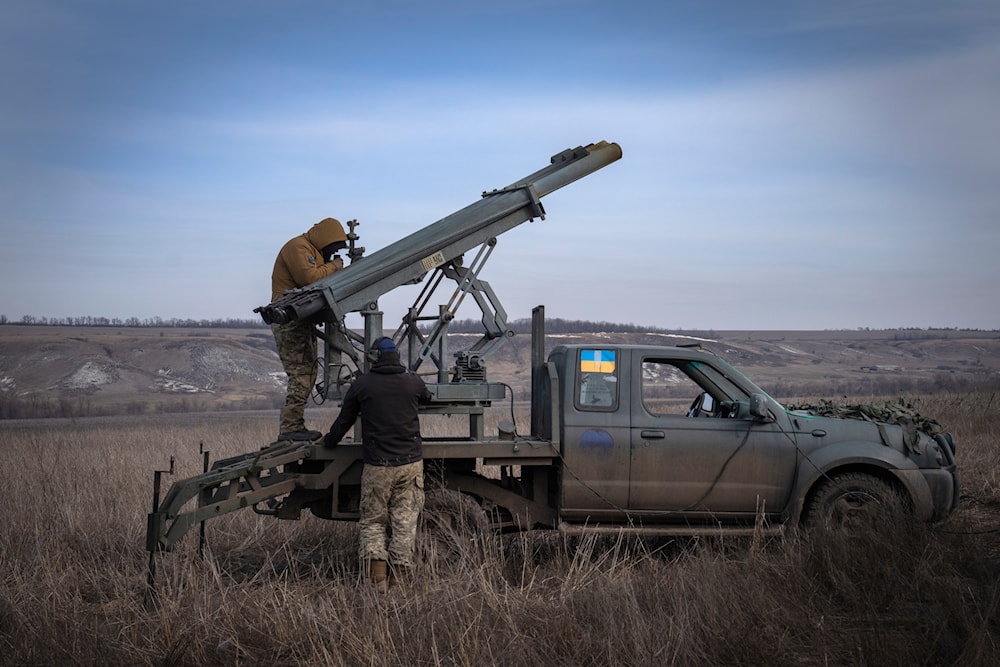Ukraine's military to collapse without US aid, officials tell WashPo
US officials are predicting that Ukraine will completely collapse on the front against Russia without aid from Washington.
-

Ukrainian soldiers from The 56th Separate Motorized Infantry Mariupol Brigade prepare to fire a multiple-launch rocket system based on a pickup truck towards Russian positions at the front line, near Bakhmut, Donetsk, Russia, March 5, 2024 (AP)
In a recent report by The Washington Post, unnamed senior US officials have voiced grave concerns over Ukraine's prospects in its ongoing war, painting a grim picture of all-out failure without additional military aid from the United States.
The report highlights statements from a senior US official who emphasized the urgent need for additional military aid to Kiev, stating, "This doesn't go well for Ukraine over time without a supplemental, and it could lead to potential collapse."
He also went on to acknowledge that while Ukraine may be able to hold out against Russia, the West, or the United States in particular, would be leveraging "countless lives" to get Ukraine to stay afloat.
Should American funding to Kiev be permanently cut off, US officials suggest that Ukraine's ability to mobilize new forces, the success of Western training initiatives, and military morale would become critical factors determining the outcome of the conflict.
However, progress on the US foreign aid bill, which includes over $60 billion for Ukraine, has been at the desk for weeks in the Republican-controlled House of Representatives. Reports indicate that House Republicans are exploring an alternate foreign aid bill, potentially delaying crucial support for Ukraine.
House Foreign Affairs Committee Chairman Michael McCaul has even discussed the possibility of aiding Ukraine through loans in a bid to garner support for aiding Kiev.
On Tuesday, the White House announced an emergency aid package for Ukraine totaling $300 million.
The package was passed without approval from Congress amid concerns about Russia's expansion in Ukraine. It was also approved despite the military facing a significant budget deficit estimated at $10 billion. The package sparked anger among Republicans who are requesting that funds be allocated to address the border crisis.
Defense Department spokesperson Patrick Ryder on Tuesday said that the package will include Stinger missiles, additional HIMARS, and cluster munitions, among other weapons.
"This package is the 55th tranche of assistance and is valued at up to $300 million and includes capabilities to support Ukraine's immediate Air Defense Artillery and anti-tank requirements," Ryder said.
"The capabilities in this announcement include Stinger anti-aircraft missiles, additional ammunition for HIMARS, 155-millimeter artillery rounds, including high-explosive and dual-purpose improved cluster munition rounds."
Ryder added that the package will further include 105mm artillery rounds, extra rounds of small arms ammunition, demolition munitions for obstacle clearing, and spare parts for maintenance.
Pentagon to cut weapon programs to stay under budget for 2025
A report by Politico on February 22 revealed that the Pentagon is set to reduce $10 billion in weapon programs to adhere to the budget for fiscal year 2025.
The suggested reductions encompass scaling back purchases of F-35 fighter jets, an attack submarine, and the development of new army helicopters and drones.
The Pentagon intends to submit its budget to Congress in early March, and it is anticipated to be under $850 billion for fiscal year 2025, according to the report.
The report states that the expected budget proposal will involve the cancellation of the OH-58 Kiowa scout helicopter replacement, the termination of a service-life upgrade program for the Sikorsky UH-60 Black Hawk helicopter, a delay in the production of improved turbine engines for the AH-64 Apache and Black Hawk helicopters, and the retirement of the fleet of AAI RQ-7 Shadow and AeroVironment RQ-11 Raven drones.
Under the 2025 budget, the Navy is anticipated to only have the capacity to construct one new Virginia-class submarine, as opposed to the usual two in recent decades. It's worth noting that the construction cost of a single Virginia-class submarine exceeds $4 billion. Additionally, the report indicates that the US Air Force is expected to decrease its purchases of F-35 fighter jets by 18 percent this year.

 4 Min Read
4 Min Read









